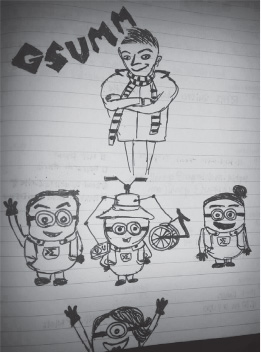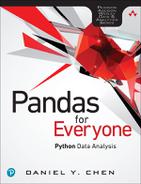Acknowledgments
Introduction to Data Science: The three people who paved the way for this book were my instructors in the “Introduction to Data Science” course at Columbia—Rachel Schutt, Kayur Patel, and Jared Lander. Without them, I wouldn’t even know what the term “data science” means. I learned so much about the field through their lectures and labs; everything I know and do today can be traced back to this class. The instructors were only part of the learning process. The people in my study group, where we fumbled through our homework assignments and applied our skills to the final project of summarizing scientific articles, made learning the material and passing the class possible. They were Niels Bantilan, Thomas Vo, Vivian Peng, and Sabrina Cheng (depicted in the figure here). Perhaps unsurprisingly, they also got me through my master’s program (more on that later).

One of the midnight doodles by Vivian Peng for our project group. We have Niels, our project leader, at the top; Thomas, me, and Sabrina in the middle row; and Vivian at the bottom.
Software-Carpentry: As part of the “Introduction to Data Science” course, I attended a Software-Carpentry workshop, where I was first introduced to Pandas. My first instructors were Justin Ely and David Warde-Farley. Since then I’ve been involved in the community, thanks to Greg Wilson, and still remember the first class I helped teach, led by Aron Ahmadia and Randal S. Olson. The many workshops that I’ve taught since then, and the fellow instructors whom I’ve met, gave me the opportunity to master the knowledge and skills I know and practice today, and to disseminate them to new learners, which has cumulated into this book.
Software-Carpentry also introduced me to the NumFOCUS, PyData, and the Scientific Python communities, where all my (Python) heroes can be found. There are too many to list here. My connection to the R world is all thanks to Jared Lander.
Columbia University Mailman School of Public Health: My undergraduate study group evolved into a set of lifelong friends during my master’s program. The members of this group got me through the first semester of the program in which epidemiology and biostatistics were first taught. The knowledge I learned in this program later transferred into my knowledge of machine learning. Thanks go to Karen Lin, Sally Cheung, Grace Lee, Wai Yee (Krystal) Khine, Ashley Harper, and Jacquie Cheung. A second set of thanks to go to my old study group alumni: Niels Bantilan, Thomas Vo, and Sabrina Cheng.
To my instructors, Katherine Keyes and Martina Pavlicova, thanks for being exemplary teachers in epidemiology, and biostatistics, respectively. Thanks also to Dana March Palmer, for whom I was a TA and who gave me my first teaching experience. Mark Orr served as my thesis advisor while I was at Mailman. The department of epidemiology had a subset of faculty who did computational and simulation modeling, under the leadership of Sandro Galea, the department chair at the time. After graduation, I got my first job as a data analyst with Jacqueline Merrill at the Columbia University School of Nursing.
Getting to Mailman was a life-altering event. I never would have considered entering an MPH program if it weren’t for Ting Ting Guo. As an advisor, Charlotte Glasser was a tremendous help to me in planning out my frequent undergraduate major changes and postgraduate plans.
Virginia Tech: The people with whom I work at the Social and Decision Analytics Laboratory (SDAL) have made Virginia Tech one of the most enjoyable places where I’ve worked. A second thanks to Mark Orr, who got me here. The administrators of the lab, Kim Lyman and Lori Conerly, make our daily lives that much easier. Sallie Keller and Stephanie Shipp, the director and the deputy lab director, respectively, create a collaborative work environment. The rest of the lab members, past and present (in no particular order)—David Higdon, Gizem Korkmaz, Vicki Lancaster, Mark Orr, Bianca Pires, Aaron Schroeder, Ian Crandell, Joshua Goldstein, Kathryn Ziemer, Emily Molfino, and Ana Aizcorbe—also work hard at making my graduate experience fun. It’s also been a pleasure to train and work with the summer undergraduate and graduate students in the lab through the Data Science for the Public Good program. I’ve learned a lot about teaching and implementing good programming practices. Finally, Brian Goode adds to my experience progressing though the program by always being available to talk about various topics.
The people down in Blacksburg, Virginia, where most of the book was written, have kept me grounded during my coursework. My PhD cohort—Alex Song Qi, Amogh Jalihal, Brittany Boribong, Bronson Weston, Jeff Law, and Long Tian—have always found time for me, and for one another, and offered opportunities to disconnect from the PhD grind. I appreciate their willingness to work to maintain our connections, despite being in an interdisciplinary program where we don’t share many classes together, let alone labs.
Brian Lewis and Caitlin Rivers helped me initially get settled in Blacksburg and gave me a physical space to work in the Network Dynamics and Simulation Science Laboratory. Here, I met Gloria Kang, Pyrros (Alex) Telionis, and James Schlitt, who have given me creative and emotional outlets the past few years. NDSSL has also provided and/or been involved with putting together some of the data sets used in the book.
Last but not least, Dennie Munson, my program liaison, can never be thanked enough for putting up with all my shenanigans.
Book Publication Process: Debra Williams Cauley, thank you so much for giving me this opportunity to contribute to the Python and data science community. I’ve grown tremendously as an educator during this process, and this adventure has opened more doors for me than the number of times I’ve missed deadlines. A second thanks to Jared Lander for recommending me and putting me up for the task.
Even more thanks go to Gloria Kang, Jacquie Cheung, and Jared Lander for their feedback during the writing process. I also want to thank Chris Zahn for all the work in reviewing the book from cover to cover, and Kaz Sakamoto and Madison Arnsbarger for providing feedback and reviews. Through their many conversations with me, M Pacer, Sebastian Raschka, Andreas Müller, and Tom Augspurger helped me make sure I covered my bases, and did things “properly.”
Thanks to all the people involved in the post-manuscript process: Julie Nahil (production editor), Jill Hobbs (copy editor), Rachel Paul (project manager and proofreader), Jack Lewis (indexer), and SPi Global (compositor). Y’all have been a pleasure to work with. More importantly, you polished my writing when it needed a little help and made sure the book was formatted consistently.
Family: My immediate and extended family have always been close. It is always a pleasure when we are together for holidays or random cookouts. It’s always surprising how the majority of the 50-plus of us manage to regularly get together throughout the year. I am extremely lucky to have the love and support from this wonderful group of people.
To my younger siblings, Eric and Julia: It’s hard being an older sibling! The two of you have always pushed me to be a better person and role model, and you bring humor, joy, and youth into my life.
A second thanks to my sister for providing the drawings in the preface and the appendix.
Last but not least, thank you, Mom and Dad, for all your support over the years. I’ve had a few last-minute career changes, and you have always been there to support my decisions, financially, emotionally, and physically—including helping me relocate between cities. Thanks to the two of you, I’ve always been able to pursue my ambitions while knowing full well I can count on your help along the way. This book is dedicated to you.
